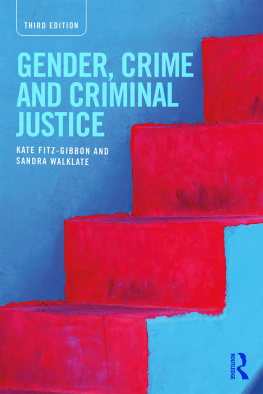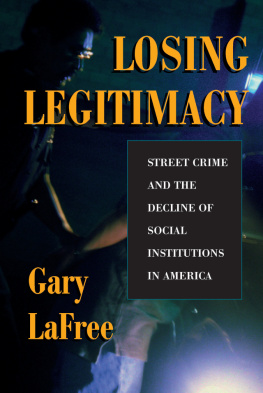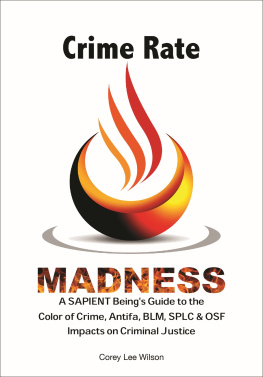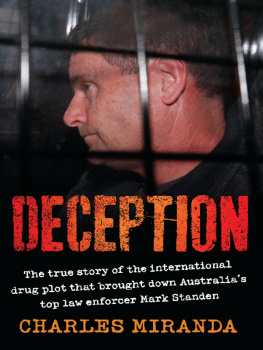THE VANISHING CRIMINAL
THE
VANISHING
CRIMINAL
CAUSES OF DECLINE IN AUSTRALIAS CRIME RATE
DON WEATHERBURN AND SARA RAHMAN

MELBOURNE UNIVERSITY PRESS
An imprint of Melbourne University Publishing Limited
Level 1, 715 Swanston Street, Carlton, Victoria 3053, Australia
www.mup.com.au

First published 2021
Text Don Weatherburn and Sara Rahman, 2021
Design and typography Melbourne University Publishing Limited, 2021
This book is copyright. Apart from any use permitted under the Copyright Act 1968 and subsequent amendments, no part may be reproduced, stored in a retrieval system or transmitted by any means or process whatsoever without the prior written permission of the publishers.
Every attempt has been made to locate the copyright holders for material quoted in this book. Any person or organisation that may have been overlooked or misattributed may contact the publisher.
Cover design by Peter Long
Typeset in 12/15pt Adobe Garamond Pro by Cannon Typesetting
Printed in Australia by McPhersons Printing Group

9780522877342 (paperback)
9780522877359 (ebook)
Contents
Preface
In the early 1990s, much to the surprise of nearly everyone, crime rates in the United States began falling and kept on falling. Between 1993 and 2017, violent crime (as measured by crime victim surveys) fell by 74 per cent, while property crime fell by 69 per cent. The crime drop was unprecedented and attracted enormous scholarly attention; however, the United States was not alone in experiencing a dramatic fall in crime. Significant reductions in crime have also been recorded in Canada, Australia, New Zealand, the United Kingdom and other parts of Western Europe. There is no scholarly consensus as yet as to what caused the crime drop in the United States, or anywhere else for that matter. Some attribute the decline to the waning of the US crack cocaine market, some attribute it to improvements in household security, while others favour explanations based on the legalisation of abortion (fewer unwanted children), the decline in atmospheric lead levels, or increased rates of imprisonment. At last count, no less than 16 theories have been put forward to explain the crime decline or some aspect of it.
The fact that crime has fallen substantially in a number of countries naturally prompts the thought that there must be a single factor or set of factors operating in each. There are, however, some noteworthy differences between countries in the timing and character of the crime decline. The fall in crime in the United States and Canada affected all major categories of crime and began in the early 1990s. The decline in crime in the United Kingdom was similar in scope but did not begin until the mid-1990s. The decline in homicide in Australia began in the late 1980s, but the property crime drop did not begin until 2001 and the decline in assault did not begin until 2008. The timing of the fall in crime in New Zealand also varied from offence to offence. These differences in the timing and character of the fall in crime suggest to us that there may not be a single explanation that applies to all the affected countriesa suspicion reinforced by the manifest differences between countries in the behaviour of factors identified as possible causes of the fall in crime.
In this book, we take each of the theories that have been put forward to explain the crime decline and assess them against the available evidence. Our assessment is in one sense quite parochial. Although our starting point is with the question of whether a particular explanatory factor has the crime-reducing effects claimed for it, we are ultimately concerned with the question of whether that factor is operating in Australia in a way that would produce a significant reduction in crime. This leads us to dismiss or discount some factors (e.g., right-to-carry gun laws, legalisation of abortion) that might have affected crime in some countries, but which are arguably of no or only limited relevance to Australia. That said, although our focus is on Australia, our inquiry should be of interest to scholars and readers in other countries because it leads us to examine factors (e.g., changes in the market for stolen goods) that have received comparatively little attention despite their potential relevance outside Australia.
It became clear to us during the course of this inquiry that the fall in property and violent crime in Australia could not reasonably be said to be the result of a single factor moving in a propitious direction. The best explanation for the decline in homicide seems to be the steady improvement in emergency medical treatment. The best explanation for the fall in assault, on the other hand, seems to be the decline in alcohol abuse among young people in response to rising alcohol prices. Changes in some factors (e.g., the fall in heroin dependence) had knock-on effects (a reduction in the number of offenders relative to the number of police; a decline in the size of the market for stolen goods) that allowed other factors (increased risk of apprehension) to exert a greater effect. Luck also played a role. Public demands for increased police accountability reached their peak just as knowledge about what works in policing began to filter into policies on police strategy and deployment. All this occurred against a backdrop of low inflation, rising real average weekly earnings and falling unemployment.
Given the unusual combination of conditions that led to the fall in crime in Australia, we remain uncertain about how long it can be expected to continue. Australia at the moment is experiencing two epidemics: one involving methamphetamine use and the other involving the highly infectious disease known as COVID-19. So far, the methamphetamine epidemic does not seem to have had a significant effect on property and violent crime, but that may change as an increasing proportion of users make the transition from recreational to dependent use. The onset of the COVID-19 epidemic has had two effects, both of which have affected or will affect crime. Its more immediate effect has been to reduce social interaction, which has brought about a further fall in property crime. Whether it results in an increase in violent crime and/or unlawful acts such as fraud, cybercrime and family violence remains to be seen. The second effect of COVID-19 is that it has brought Australias economic dream run (25 years since the last recession) to an abrupt end. The effects of this will take time to play out.
CHAPTER 1
THE RISE AND FALL IN AUSTRALIAN CRIME
Baby Boomers Cut Loose
On the morning of 31 January 1984, 35-year-old Hakki Tim Bahadir Atahan entered the Commonwealth Bank in George Street, Sydney intending to rob the bank, only to find the building surrounded by heavily armed police. A few hours of failed negotiation followed before Atahan forced five hostages into a Datsun sedan and instructed one of them to drive towards Manly, a beachside suburb north of the CBD. The Datsun, followed by a swarm of police cars and a police helicopter, made it to the Spit Bridge where it was forced to stoppolice had raised the bridge to prevent any further escape. Detective Senior Constable Steve Canelis, who had been in one of the pursuing police cars, walked over to Atahan hoping to negotiate his surrender. Without warning, Atahan shot him and was then himself shot dead by other police. The hostages and Detective Senior Constable Canelis all survived, although Canelis later left the police with a bullet still lodged in his shoulder (Anderson 2014).
Next page










